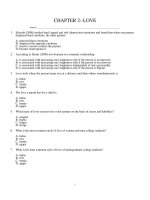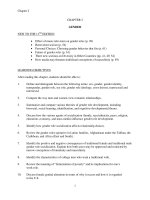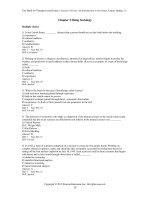IT training discovering knowledge in data an introduction to data mining (2nd ed ) larose larose 2014 06 30
Bạn đang xem bản rút gọn của tài liệu. Xem và tải ngay bản đầy đủ của tài liệu tại đây (6.07 MB, 336 trang )
Wiley Series on Methods and
Applications in Data Mining
Daniel T. Larose, Series Editor
Second Edition
DISCOVERING
KNOWLEDGE IN DATA
An Introduction to Data Mining
Daniel T. Larose • Chantal D. Larose
DISCOVERING
KNOWLEDGE IN DATA
WILEY SERIES ON METHODS AND APPLICATIONS
IN DATA MINING
Series Editor: Daniel T. Larose
Discovering Knowledge in Data: An Introduction to Data Mining, Second Edition r
Daniel T. Larose and Chantal D. Larose
Data Mining for Genomics and Proteomics: Analysis of Gene and Protein Expression
Data r Darius M. Dziuda
Knowledge Discovery with Support Vector Machines r Lutz Hamel
Data-Mining on the Web: Uncovering Patterns in Web Content, Structure, and Usage r
Zdravko Markov and Daniel Larose
Data Mining Methods and Models r Daniel Larose
Practical Text Mining with Perl r Roger Bilisoly
SECOND EDITION
DISCOVERING
KNOWLEDGE IN DATA
An Introduction to Data Mining
DANIEL T. LAROSE
CHANTAL D. LAROSE
Copyright © 2014 by John Wiley & Sons, Inc. All rights reserved.
Published by John Wiley & Sons, Inc., Hoboken, New Jersey.
Published simultaneously in Canada.
No part of this publication may be reproduced, stored in a retrieval system, or transmitted in any form or
by any means, electronic, mechanical, photocopying, recording, scanning, or otherwise, except as
permitted under Section 107 or 108 of the 1976 United States Copyright Act, without either the prior
written permission of the Publisher, or authorization through payment of the appropriate per-copy fee to
the Copyright Clearance Center, Inc., 222 Rosewood Drive, Danvers, MA 01923, (978) 750-8400, fax
(978) 750-4470, or on the web at www.copyright.com. Requests to the Publisher for permission should
be addressed to the Permissions Department, John Wiley & Sons, Inc., 111 River Street, Hoboken, NJ
07030, (201) 748-6011, fax (201) 748-6008, or online at />Limit of Liability/Disclaimer of Warranty: While the publisher and author have used their best efforts in
preparing this book, they make no representations or warranties with respect to the accuracy or
completeness of the contents of this book and specifically disclaim any implied warranties of
merchantability or fitness for a particular purpose. No warranty may be created or extended by sales
representatives or written sales materials. The advice and strategies contained herein may not be suitable
for your situation. You should consult with a professional where appropriate. Neither the publisher nor
author shall be liable for any loss of profit or any other commercial damages, including but not limited to
special, incidental, consequential, or other damages.
For general information on our other products and services or for technical support, please contact our
Customer Care Department within the United States at (800) 762-2974, outside the United States at (317)
572-3993 or fax (317) 572-4002.
Wiley also publishes its books in a variety of electronic formats. Some content that appears in print may
not be available in electronic formats. For more information about Wiley products, visit our website at
www.wiley.com.
Library of Congress Cataloging-in-Publication Data:
Larose, Daniel T.
Discovering knowledge in data : an introduction to data mining / Daniel T. Larose and
Chantal D. Larose. – Second edition.
pages cm
Includes index.
ISBN 978-0-470-90874-7 (hardback)
1. Data mining. I. Larose, Chantal D. II. Title.
QA76.9.D343L38 2014
006.3′ 12–dc23
2013046021
Printed in the United States of America
10 9 8 7 6 5 4 3 2 1
CONTENTS
PREFACE
CHAPTER 1
1.1
1.2
1.3
1.4
1.5
1.6
AN INTRODUCTION TO DATA MINING
What is Data Mining? 1
Wanted: Data Miners 2
The Need for Human Direction of Data Mining 3
The Cross-Industry Standard Practice for Data Mining
1.4.1 Crisp-DM: The Six Phases 5
Fallacies of Data Mining 6
What Tasks Can Data Mining Accomplish? 8
1.6.1 Description 8
1.6.2 Estimation 8
1.6.3 Prediction 10
1.6.4 Classification 10
1.6.5 Clustering 12
1.6.6 Association 14
References 14
Exercises 15
CHAPTER 2
2.1
2.2
2.3
2.4
2.5
2.6
2.7
2.8
2.9
2.10
2.11
2.12
2.13
2.14
2.15
2.16
2.17
2.18
2.19
2.20
xi
1
4
DATA PREPROCESSING
Why do We Need to Preprocess the Data? 17
Data Cleaning 17
Handling Missing Data 19
Identifying Misclassifications 22
Graphical Methods for Identifying Outliers 22
Measures of Center and Spread 23
Data Transformation 26
Min-Max Normalization 26
Z-Score Standardization 27
Decimal Scaling 28
Transformations to Achieve Normality 28
Numerical Methods for Identifying Outliers 35
Flag Variables 36
Transforming Categorical Variables into Numerical Variables
Binning Numerical Variables 38
Reclassifying Categorical Variables 39
Adding an Index Field 39
Removing Variables that are Not Useful 39
Variables that Should Probably Not Be Removed 40
Removal of Duplicate Records 41
16
37
v
vi
2.21
CONTENTS
A Word About ID Fields
The R Zone 42
References 48
Exercises 48
Hands-On Analysis 50
CHAPTER 3
3.1
3.2
3.3
3.4
3.5
3.6
3.7
3.8
3.9
3.10
3.11
3.12
51
71
UNIVARIATE STATISTICAL ANALYSIS
91
Data Mining Tasks in Discovering Knowledge in Data 91
Statistical Approaches to Estimation and Prediction 92
Statistical Inference 93
How Confident are We in Our Estimates? 94
Confidence Interval Estimation of the Mean 95
How to Reduce the Margin of Error 97
Confidence Interval Estimation of the Proportion 98
Hypothesis Testing for the Mean 99
Assessing the Strength of Evidence Against the Null Hypothesis
Using Confidence Intervals to Perform Hypothesis Tests 102
Hypothesis Testing for the Proportion 104
The R Zone 105
Reference 106
Exercises 106
CHAPTER 5
5.1
5.2
5.3
5.4
5.5
5.6
EXPLORATORY DATA ANALYSIS
Hypothesis Testing Versus Exploratory Data Analysis 51
Getting to Know the Data Set 52
Exploring Categorical Variables 55
Exploring Numeric Variables 62
Exploring Multivariate Relationships 69
Selecting Interesting Subsets of the Data for Further Investigation
Using EDA to Uncover Anomalous Fields 71
Binning Based on Predictive Value 72
Deriving New Variables: Flag Variables 74
Deriving New Variables: Numerical Variables 77
Using EDA to Investigate Correlated Predictor Variables 77
Summary 80
The R Zone 82
Reference 88
Exercises 88
Hands-On Analysis 89
CHAPTER 4
4.1
4.2
4.3
4.4
4.5
4.6
4.7
4.8
4.9
4.10
4.11
41
MULTIVARIATE STATISTICS
Two-Sample t-Test for Difference in Means 110
Two-Sample Z-Test for Difference in Proportions 111
Test for Homogeneity of Proportions 112
Chi-Square Test for Goodness of Fit of Multinomial Data
Analysis of Variance 115
Regression Analysis 118
101
109
114
CONTENTS
5.7
5.8
5.9
5.10
5.11
5.12
5.13
Hypothesis Testing in Regression 122
Measuring the Quality of a Regression Model 123
Dangers of Extrapolation 123
Confidence Intervals for the Mean Value of y Given x 125
Prediction Intervals for a Randomly Chosen Value of y Given x
Multiple Regression 126
Verifying Model Assumptions 127
The R Zone 131
Reference 135
Exercises 135
Hands-On Analysis 136
CHAPTER 6
6.1
6.2
6.3
6.4
6.5
6.6
6.7
CHAPTER 7
7.1
7.2
7.3
7.4
7.5
7.6
7.7
7.8
7.9
138
139
k-NEAREST NEIGHBOR ALGORITHM
Classification Task 149
k-Nearest Neighbor Algorithm 150
Distance Function 153
Combination Function 156
7.4.1 Simple Unweighted Voting 156
7.4.2 Weighted Voting 156
Quantifying Attribute Relevance: Stretching the Axes 158
Database Considerations 158
k-Nearest Neighbor Algorithm for Estimation and Prediction 159
Choosing k 160
Application of k-Nearest Neighbor Algorithm Using IBM/SPSS Modeler
The R Zone 162
Exercises 163
Hands-On Analysis 164
CHAPTER 8
8.1
8.2
8.3
8.4
8.5
125
PREPARING TO MODEL THE DATA
Supervised Versus Unsupervised Methods 138
Statistical Methodology and Data Mining Methodology
Cross-Validation 139
Overfitting 141
BIAS–Variance Trade-Off 142
Balancing the Training Data Set 144
Establishing Baseline Performance 145
The R Zone 146
Reference 147
Exercises 147
DECISION TREES
What is a Decision Tree? 165
Requirements for Using Decision Trees
Classification and Regression Trees 168
C4.5 Algorithm 174
Decision Rules 179
vii
149
160
165
167
viii
CONTENTS
8.6
Comparison of the C5.0 and Cart Algorithms Applied to Real Data
The R Zone 183
References 184
Exercises 185
Hands-On Analysis 185
CHAPTER 9
9.1
9.2
9.3
9.4
9.5
9.6
9.7
9.8
9.9
9.10
10.1
10.2
10.3
10.4
10.5
10.6
10.7
10.8
10.9
NEURAL NETWORKS
Input and Output Encoding 188
Neural Networks for Estimation and Prediction
Simple Example of a Neural Network 191
Sigmoid Activation Function 193
Back-Propagation 194
9.5.1 Gradient Descent Method 194
9.5.2 Back-Propagation Rules 195
9.5.3 Example of Back-Propagation 196
Termination Criteria 198
Learning Rate 198
Momentum Term 199
Sensitivity Analysis 201
Application of Neural Network Modeling 202
The R Zone 204
References 207
Exercises 207
Hands-On Analysis 207
CHAPTER 10
180
187
190
HIERARCHICAL AND k-MEANS CLUSTERING
The Clustering Task 209
Hierarchical Clustering Methods 212
Single-Linkage Clustering 213
Complete-Linkage Clustering 214
k-Means Clustering 215
Example of k-Means Clustering at Work 216
Behavior of MSB, MSE, and PSEUDO-F as the k-Means Algorithm Proceeds
Application of k-Means Clustering Using SAS Enterprise Miner 220
Using Cluster Membership to Predict Churn 223
The R Zone 224
References 226
Exercises 226
Hands-On Analysis 226
CHAPTER 11
KOHONEN NETWORKS
Self-Organizing Maps 228
Kohonen Networks 230
11.2.1 Kohonen Networks Algorithm 231
11.3 Example of a Kohonen Network Study 231
11.4 Cluster Validity 235
11.5 Application of Clustering Using Kohonen Networks
209
219
228
11.1
11.2
235
CONTENTS
Interpreting the Clusters 237
11.6.1 Cluster Profiles 240
11.7 Using Cluster Membership as Input to Downstream Data Mining Models
The R Zone 243
References 245
Exercises 245
Hands-On Analysis 245
ix
11.6
CHAPTER 12
12.1
12.2
12.3
12.4
12.5
12.6
12.7
12.8
12.9
13.1
13.2
13.3
13.4
13.5
247
256
260
IMPUTATION OF MISSING DATA
Need for Imputation of Missing Data 266
Imputation of Missing Data: Continuous Variables
Standard Error of the Imputation 270
Imputation of Missing Data: Categorical Variables
Handling Patterns in Missingness 272
The R Zone 273
Reference 276
Exercises 276
Hands-On Analysis 276
CHAPTER 14
14.1
14.2
14.3
14.4
14.5
14.6
14.7
14.8
ASSOCIATION RULES
Affinity Analysis and Market Basket Analysis 247
12.1.1 Data Representation for Market Basket Analysis 248
Support, Confidence, Frequent Itemsets, and the a Priori Property 249
How Does the a Priori Algorithm Work? 251
12.3.1 Generating Frequent Itemsets 251
12.3.2 Generating Association Rules 253
Extension from Flag Data to General Categorical Data 255
Information-Theoretic Approach: Generalized Rule Induction Method
12.5.1 J-Measure 257
Association Rules are Easy to do Badly 258
How Can We Measure the Usefulness of Association Rules? 259
Do Association Rules Represent Supervised or Unsupervised Learning?
Local Patterns Versus Global Models 261
The R Zone 262
References 263
Exercises 263
Hands-On Analysis 264
CHAPTER 13
242
266
267
271
MODEL EVALUATION TECHNIQUES
Model Evaluation Techniques for the Description Task 278
Model Evaluation Techniques for the Estimation and Prediction Tasks 278
Model Evaluation Techniques for the Classification Task 280
Error Rate, False Positives, and False Negatives 280
Sensitivity and Specificity 283
Misclassification Cost Adjustment to Reflect Real-World Concerns 284
Decision Cost/Benefit Analysis 285
Lift Charts and Gains Charts 286
277
x
CONTENTS
14.9
14.10
Interweaving Model Evaluation with Model Building 289
Confluence of Results: Applying a Suite of Models 290
The R Zone 291
Reference 291
Exercises 291
Hands-On Analysis 291
APPENDIX: DATA SUMMARIZATION AND VISUALIZATION
294
INDEX
309
PREFACE
WHAT IS DATA MINING?
According to the Gartner Group,
Data mining is the process of discovering meaningful new correlations, patterns and
trends by sifting through large amounts of data stored in repositories, using pattern
recognition technologies as well as statistical and mathematical techniques.
Today, there are a variety of terms used to describe this process, including analytics, predictive analytics, big data, machine learning, and knowledge discovery in
databases. But these terms all share in common the objective of mining actionable
nuggets of knowledge from large data sets. We shall therefore use the term data
mining to represent this process throughout this text.
WHY IS THIS BOOK NEEDED?
Humans are inundated with data in most fields. Unfortunately, these valuable data,
which cost firms millions to collect and collate, are languishing in warehouses and
repositories. The problem is that there are not enough trained human analysts available who are skilled at translating all of these data into knowledge, and thence up
the taxonomy tree into wisdom. This is why this book is needed.
The McKinsey Global Institute reports:1
There will be a shortage of talent necessary for organizations to take advantage of big
data. A significant constraint on realizing value from big data will be a shortage of talent,
particularly of people with deep expertise in statistics and machine learning, and the
managers and analysts who know how to operate companies by using insights from big
data . . . . We project that demand for deep analytical positions in a big data world could
exceed the supply being produced on current trends by 140,000 to 190,000 positions.
. . . In addition, we project a need for 1.5 million additional managers and analysts in
the United States who can ask the right questions and consume the results of the analysis
of big data effectively.
This book is an attempt to help alleviate this critical shortage of data analysts.
Discovering Knowledge in Data: An Introduction to Data Mining provides readers
with:
r The models and techniques to uncover hidden nuggets of information,
1 Big data: The next frontier for innovation, competition, and productivity, by James Manyika et al.,
Mckinsey Global Institute, www.mckinsey.com, May, 2011. Last accessed March 16, 2014.
xi
xii
PREFACE
r The insight into how the data mining algorithms really work, and
r The experience of actually performing data mining on large data sets.
Data mining is becoming more widespread everyday, because it empowers companies
to uncover profitable patterns and trends from their existing databases. Companies
and institutions have spent millions of dollars to collect megabytes and terabytes of
data, but are not taking advantage of the valuable and actionable information hidden
deep within their data repositories. However, as the practice of data mining becomes
more widespread, companies which do not apply these techniques are in danger of
falling behind, and losing market share, because their competitors are applying data
mining, and thereby gaining the competitive edge.
In Discovering Knowledge in Data, the step-by-step, hands-on solutions of
real-world business problems, using widely available data mining techniques applied
to real-world data sets, will appeal to managers, CIOs, CEOs, CFOs, and others who
need to keep abreast of the latest methods for enhancing return-on-investment.
WHAT’S NEW FOR THE SECOND EDITION?
The second edition of Discovery Knowledge in Data is enhanced with an abundance
of new material and useful features, including:
r Nearly 100 pages of new material.
r Three new chapters:
❡
❡
❡
Chapter 5: Multivariate Statistical Analysis covers the hypothesis tests used
for verifying whether data partitions are valid, along with analysis of variance, multiple regression, and other topics.
Chapter 6: Preparing to Model the Data introduces a new formula for balancing the training data set, and examines the importance of establishing
baseline performance, among other topics.
Chapter 13: Imputation of Missing Data addresses one of the most overlooked issues in data analysis, and shows how to impute missing values for
continuous variables and for categorical variables, as well as how to handle
patterns in missingness.
r The R Zone. In most chapters of this book, the reader will find The R Zone,
which provides the actual R code needed to obtain the results shown in the
chapter, along with screen shots of some of the output, using R Studio.
r A host of new topics not covered in the first edition. Here is a sample of these
new topics, chapter by chapter:
❡
Chapter 2: Data Preprocessing. Decimal scaling; Transformations to achieve
normality; Flag variables; Transforming categorical variables into numerical
variables; Binning numerical variables; Reclassifying categorical variables;
Adding an index field; Removal of duplicate records.
PREFACE
❡
❡
xiii
Chapter 3: Exploratory Data Analysis. Binning based on predictive value;
Deriving new variables: Flag variables; Deriving new variables: Numerical
variables; Using EDA to investigate correlated predictor variables.
Chapter 4: Univariate Statistical Analysis. How to reduce the margin of
error; Confidence interval estimation of the proportion; Hypothesis testing
for the mean; Assessing the strength of evidence against the null hypothesis;
Using confidence intervals to perform hypothesis tests; Hypothesis testing
for the proportion.
❡
Chapter 5: Multivariate Statistics. Two-sample test for difference in means;
Two-sample test for difference in proportions; Test for homogeneity of proportions; Chi-square test for goodness of fit of multinomial data; Analysis
of variance; Hypothesis testing in regression; Measuring the quality of a
regression model.
❡
Chapter 6: Preparing to Model the Data. Balancing the training data set;
Establishing baseline performance.
Chapter 7: k-Nearest Neighbor Algorithm. Application of k-nearest neighbor
algorithm using IBM/SPSS Modeler.
Chapter 10: Hierarchical and k-Means Clustering. Behavior of MSB, MSE,
and pseudo-F as the k-means algorithm proceeds.
Chapter 12: Association Rules. How can we measure the usefulness of association rules?
❡
❡
❡
❡
Chapter 13: Imputation of Missing Data. Need for imputation of missing
data; Imputation of missing data for continuous variables; Imputation of
missing data for categorical variables; Handling patterns in missingness.
❡
Chapter 14: Model Evaluation Techniques. Sensitivity and Specificity.
r An Appendix on Data Summarization and Visualization. Readers who may be a
bit rusty on introductory statistics may find this new feature helpful. Definitions
and illustrative examples of introductory statistical concepts are provided here,
along with many graphs and tables, as follows:
❡
Part 1: Summarization 1: Building Blocks of Data Analysis
❡
Part 2: Visualization: Graphs and Tables for Summarizing and Organizing
Data
❡
Part 3: Summarization 2: Measures of Center, Variability, and Position
❡
Part 4: Summarization and Visualization of Bivariate Relationships
r New Exercises. There are over 100 new chapter exercises in the second edition.
DANGER! DATA MINING IS EASY TO DO BADLY
The plethora of new off-the-shelf software platforms for performing data mining has
kindled a new kind of danger. The ease with which these graphical user interface
(GUI)-based applications can manipulate data, combined with the power of the
xiv
PREFACE
formidable data mining algorithms embedded in the black box software currently
available, makes their misuse proportionally more hazardous.
Just as with any new information technology, data mining is easy to do badly. A
little knowledge is especially dangerous when it comes to applying powerful models
based on large data sets. For example, analyses carried out on unpreprocessed data
can lead to erroneous conclusions, or inappropriate analysis may be applied to data
sets that call for a completely different approach, or models may be derived that are
built upon wholly specious assumptions. These errors in analysis can lead to very
expensive failures, if deployed.
“WHITE BOX” APPROACH: UNDERSTANDING
THE UNDERLYING ALGORITHMIC AND MODEL
STRUCTURES
The best way to avoid these costly errors, which stem from a blind black-box approach
to data mining, is to instead apply a “white-box” methodology, which emphasizes
an understanding of the algorithmic and statistical model structures underlying the
software.
Discovering Knowledge in Data applies this white-box approach by:
r
r
r
r
Walking the reader through the various algorithms;
Providing examples of the operation of the algorithm on actual large data sets;
Testing the reader’s level of understanding of the concepts and algorithms;
Providing an opportunity for the reader to do some real data mining on large
data sets; and
r Supplying the reader with the actual R code used to achieve these data mining
results, in The R Zone.
Algorithm Walk-Throughs
Discovering Knowledge in Data walks the reader through the operations and nuances
of the various algorithms, using small sample data sets, so that the reader gets a true
appreciation of what is really going on inside the algorithm. For example, in Chapter
10, Hierarchical and K-Means Clustering, we see the updated cluster centers being
updated, moving toward the center of their respective clusters. Also, in Chapter
11, Kohonen Networks, we see just which kind of network weights will result in a
particular network node “winning” a particular record.
Applications of the Algorithms to Large Data Sets
Discovering Knowledge in Data provides examples of the application of the various
algorithms on actual large data sets. For example, in Chapter 9, Neural Networks,
a classification problem is attacked using a neural network model on a real-world
data set. The resulting neural network topology is examined, along with the network
connection weights, as reported by the software. These data sets are included on the
PREFACE
xv
data disk, so that the reader may follow the analytical steps on their own, using data
mining software of their choice.
Chapter Exercises: Check Your Understanding
Discovering Knowledge in Data includes over 260 chapter exercises, which allow
readers to assess their depth of understanding of the material, as well as have a little
fun playing with numbers and data. These include conceptual exercises, which help
to clarify some of the more challenging concepts in data mining, and “Tiny data set”
exercises, which challenge the reader to apply the particular data mining algorithm
to a small data set, and, step-by-step, to arrive at a computationally sound solution.
For example, in Chapter 8, Decision Trees, readers are provided with a small data
set and asked to construct—by hand, using the methods shown in the chapter—a
C4.5 decision tree model, as well as a classification and regression tree model, and
to compare the benefits and drawbacks of each.
Hands-On Analysis: Learn Data Mining by Doing Data Mining
Most chapters provide hands-on analysis problems, representing an opportunity for
the reader to apply newly-acquired data mining expertise to solving real problems
using large data sets. Many people learn by doing. This book provides a framework
where the reader can learn data mining by doing data mining.
The intention is to mirror the real-world data mining scenario. In the real world,
dirty data sets need to be cleaned; raw data needs to be normalized; outliers need to
be checked. So it is with Discovering Knowledge in Data, where about 100 hands-on
analysis problems are provided. The reader can “ramp up” quickly, and be “up and
running” data mining analyses in a short time.
For example, in Chapter 12, Association Rules, readers are challenged to
uncover high confidence, high support rules for predicting which customer will be
leaving the company’s service. In Chapter 14, Model Evaluation Techniques, readers
are asked to produce lift charts and gains charts for a set of classification models
using a large data set, so that the best model may be identified.
The R Zone
R is a powerful, open-source language for exploring and analyzing data sets (www.rproject.org). Analysts using R can take advantage of many freely available packages,
routines, and GUIs, to tackle most data analysis problems. In most chapters of this
book, the reader will find The R Zone, which provides the actual R code needed to
obtain the results shown in the chapter, along with screen shots of some of the output.
The R Zone is written by Chantal D. Larose (Ph.D. candidate in Statistics, University
of Connecticut, Storrs), daughter of the author, and R expert, who uses R extensively
in her research, including research on multiple imputation of missing data, with her
dissertation advisors, Dr. Dipak Dey and Dr. Ofer Harel.
xvi
PREFACE
DATA MINING AS A PROCESS
One of the fallacies associated with data mining implementations is that data mining
somehow represents an isolated set of tools, to be applied by an aloof analysis
department, and marginally related to the mainstream business or research endeavor.
Organizations which attempt to implement data mining in this way will see their
chances of success much reduced. Data mining should be viewed as a process.
Discovering Knowledge in Data presents data mining as a well-structured
standard process, intimately connected with managers, decision makers, and those
involved in deploying the results. Thus, this book is not only for analysts, but for
managers as well, who need to communicate in the language of data mining.
The standard process used is the CRISP-DM framework: the Cross-Industry
Standard Process for Data Mining. CRISP-DM demands that data mining be seen as
an entire process, from communication of the business problem, through data collection and management, data preprocessing, model building, model evaluation, and,
finally, model deployment. Therefore, this book is not only for analysts and managers,
but also for data management professionals, database analysts, and decision makers.
GRAPHICAL APPROACH, EMPHASIZING EXPLORATORY
DATA ANALYSIS
Discovering Knowledge in Data emphasizes a graphical approach to data analysis.
There are more than 170 screen shots of computer output throughout the text, and 40
other figures. Exploratory data analysis (EDA) represents an interesting and fun way
to “feel your way” through large data sets. Using graphical and numerical summaries,
the analyst gradually sheds light on the complex relationships hidden within the data.
Discovering Knowledge in Data emphasizes an EDA approach to data mining, which
goes hand-in-hand with the overall graphical approach.
HOW THE BOOK IS STRUCTURED
Discovering Knowledge in Data: An Introduction to Data Mining provides a comprehensive introduction to the field. Common myths about data mining are debunked, and
common pitfalls are flagged, so that new data miners do not have to learn these lessons
themselves. The first three chapters introduce and follow the CRISP-DM standard
process, especially the data preparation phase and data understanding phase. The next
nine chapters represent the heart of the book, and are associated with the CRISP-DM
modeling phase. Each chapter presents data mining methods and techniques for a
specific data mining task.
r Chapters 4 and 5 examine univariate and multivariate statistical analyses,
respectively, and exemplify the estimation and prediction tasks, for example,
using multiple regression.
PREFACE
xvii
r Chapters 7–9 relate to the classification task, examining k-nearest neighbor
(Chapter 7), decision trees (Chapter 8), and neural network (Chapter 9) algorithms.
r Chapters 10 and 11 investigate the clustering task, with hierarchical and kmeans clustering (Chapter 10) and Kohonen networks (Chapter 11) algorithms.
r Chapter 12 handles the association task, examining association rules through
the a priori and GRI algorithms.
r Finally, Chapter 14 considers model evaluation techniques, which belong to
the CRISP-DM evaluation phase.
Discovering Knowledge in Data as a Textbook
Discovering Knowledge in Data: An Introduction to Data Mining naturally fits the
role of textbook for an introductory course in data mining. Instructors may appreciate:
r The presentation of data mining as a process
r The “White-box” approach, emphasizing an understanding of the underlying
algorithmic structures
❡
Algorithm walk-throughs
❡
❡
❡
❡
Application of the algorithms to large data sets
Chapter exercises
Hands-on analysis, and
The R Zone
r The graphical approach, emphasizing exploratory data analysis, and
r The logical presentation, flowing naturally from the CRISP-DM standard process and the set of data mining tasks.
Discovering Knowledge in Data is appropriate for advanced undergraduate or
graduate-level courses. Except for one section in the neural networks chapter, no
calculus is required. An introductory statistics course would be nice, but is not
required. No computer programming or database expertise is required.
ACKNOWLEDGMENTS
I first wish to thank my mentor Dr. Dipak K. Dey, Distinguished Professor of Statistics,
and Associate Dean of the College of Liberal Arts and Sciences at the University of
Connecticut, as well as Dr. John Judge, Professor of Statistics in the Department of
Mathematics at Westfield State College. My debt to the two of you is boundless, and
now extends beyond one lifetime. Also, I wish to thank my colleagues in the data
mining programs at Central Connecticut State University: Dr. Chun Jin, Dr. Daniel
S. Miller, Dr. Roger Bilisoly, Dr. Darius Dziuda, and Dr. Krishna Saha. Thanks to
my daughter Chantal Danielle Larose, for her important contribution to this book,
as well as for her cheerful affection and gentle insanity. Thanks to my twin children
xviii
PREFACE
Tristan Spring and Ravel Renaissance for providing perspective on what life is really
about. Finally, I would like to thank my wonderful wife, Debra J. Larose, for our life
together.
Daniel T. Larose, Ph.D.
Professor of Statistics and Data Mining
Director, Data Mining@CCSU
www.math.ccsu.edu/larose
I would first like to thank my PhD advisors, Dr. Dipak Dey, Distinguished Professor
and Associate Dean, and Dr. Ofer Harel, Associate Professor, both from the Department of Statistics at the University of Connecticut. Their insight and understanding
have framed and sculpted our exciting research program, including my PhD dissertation, Model-Based Clustering of Incomplete Data. Thanks also to my father Daniel
for kindling my enduring love of data analysis, and to my mother Debra for her
care and patience through many statistics-filled conversations. Finally thanks to my
siblings, Ravel and Tristan, for perspective, music, and friendship.
Chantal D. Larose, MS
Department of Statistics
University of Connecticut
Let us settle ourselves, and work, and wedge our feet downwards through the mud and
slush of opinion and tradition and prejudice and appearance and delusion, . . . till we
come to a hard bottom with rocks in place which we can call reality and say, “This is,
and no mistake.”
Henry David Thoreau
CHAPTER
1
AN INTRODUCTION TO
DATA MINING
1.1
WHAT IS DATA MINING? 1
1.2
WANTED: DATA MINERS 2
1.3
THE NEED FOR HUMAN DIRECTION OF DATA MINING 3
1.4
THE CROSS-INDUSTRY STANDARD PRACTICE FOR DATA MINING
1.5
FALLACIES OF DATA MINING
1.6
WHAT TASKS CAN DATA MINING ACCOMPLISH? 8
REFERENCES
4
6
14
EXERCISES 15
1.1
WHAT IS DATA MINING?
The McKinsey Global Institute (MGI) reports [1] that most American companies with
more than 1000 employees had an average of at least 200 terabytes of stored data. MGI
projects that the amount of data generated worldwide will increase by 40% annually,
creating profitable opportunities for companies to leverage their data to reduce costs
and increase their bottom line. For example, retailers harnessing this “big data” to best
advantage could expect to realize an increase in their operating margin of more than
60%, according to the MGI report. And healthcare providers and health maintenance
organizations (HMOs) that properly leverage their data storehouses could achieve
$300 in cost savings annually, through improved efficiency and quality.
The MIT Technology Review reports [2] that it was the Obama campaign’s
effective use of data mining that helped President Obama win the 2012 presidential
election over Mitt Romney. They first identified likely Obama voters using a data
mining model, and then made sure that these voters actually got to the polls. The
campaign also used a separate data mining model to predict the polling outcomes
Discovering Knowledge in Data: An Introduction to Data Mining, Second Edition.
By Daniel T. Larose and Chantal D. Larose.
© 2014 John Wiley & Sons, Inc. Published 2014 by John Wiley & Sons, Inc.
1
2
CHAPTER 1
AN INTRODUCTION TO DATA MINING
county-by-county. In the important swing county of Hamilton County, Ohio, the
model predicted that Obama would receive 56.4% of the vote; the Obama share of the
actual vote was 56.6%, so that the prediction was off by only 0.02%. Such precise predictive power allowed the campaign staff to allocate scarce resources more efficiently.
About 13 million customers per month contact the West Coast customer service
call center of the Bank of America, as reported by CIO Magazine [3]. In the past,
each caller would have listened to the same marketing advertisement, whether or not
it was relevant to the caller’s interests. However, “rather than pitch the product of the
week, we want to be as relevant as possible to each customer,” states Chris Kelly, vice
president and director of database marketing at Bank of America in San Francisco.
Thus Bank of America’s customer service representatives have access to individual
customer profiles, so that the customer can be informed of new products or services
that may be of greatest interest to him or her. This is an example of mining customer
data to help identify the type of marketing approach for a particular customer, based
on customer’s individual profile.
So, what is data mining?
Data mining is the process of discovering useful patterns and trends in large data
sets.
While waiting in line at a large supermarket, have you ever just closed your
eyes and listened? You might hear the beep, beep, beep, of the supermarket scanners,
reading the bar codes on the grocery items, ringing up on the register, and storing
the data on company servers. Each beep indicates a new row in the database, a new
“observation” in the information being collected about the shopping habits of your
family, and the other families who are checking out.
Clearly, a lot of data is being collected. However, what is being learned from
all this data? What knowledge are we gaining from all this information? Probably
not as much as you might think, because there is a serious shortage of skilled data
analysts.
1.2
WANTED: DATA MINERS
As early as 1984, in his book Megatrends [4], John Naisbitt observed that “We are
drowning in information but starved for knowledge.” The problem today is not that
there is not enough data and information streaming in. We are in fact inundated with
data in most fields. Rather, the problem is that there are not enough trained human
analysts available who are skilled at translating all of these data into knowledge, and
thence up the taxonomy tree into wisdom.
The ongoing remarkable growth in the field of data mining and knowledge
discovery has been fueled by a fortunate confluence of a variety of factors:
r The explosive growth in data collection, as exemplified by the supermarket
scanners above,
1.3 THE NEED FOR HUMAN DIRECTION OF DATA MINING
3
r The storing of the data in data warehouses, so that the entire enterprise has
r
r
r
r
access to a reliable, current database,
The availability of increased access to data from web navigation and intranets,
The competitive pressure to increase market share in a globalized economy,
The development of “off-the-shelf” commercial data mining software suites,
The tremendous growth in computing power and storage capacity.
Unfortunately, according to the McKinsey report [1],
There will be a shortage of talent necessary for organizations to take advantage of big
data. A significant constraint on realizing value from big data will be a shortage of talent,
particularly of people with deep expertise in statistics and machine learning, and the
managers and analysts who know how to operate companies by using insights from big
data . . . . We project that demand for deep analytical positions in a big data world could
exceed the supply being produced on current trends by 140,000 to 190,000 positions. . . .
In addition, we project a need for 1.5 million additional managers and analysts in the
United States who can ask the right questions and consume the results of the analysis
of big data effectively.
This book is an attempt to help alleviate this critical shortage of data analysts.
1.3 THE NEED FOR HUMAN DIRECTION
OF DATA MINING
Many software vendors market their analytical software as being a plug-and-play, outof-the-box application that will provide solutions to otherwise intractable problems,
without the need for human supervision or interaction. Some early definitions of data
mining followed this focus on automation. For example, Berry and Linoff, in their
book Data Mining Techniques for Marketing, Sales and Customer Support [5] gave
the following definition for data mining: “Data mining is the process of exploration
and analysis, by automatic or semi-automatic means, of large quantities of data in
order to discover meaningful patterns and rules” [emphasis added]. Three years later,
in their sequel Mastering Data Mining [6], the authors revisit their definition of data
mining, and mention that, “If there is anything we regret, it is the phrase ‘by automatic
or semi-automatic means’ . . . because we feel there has come to be too much focus
on the automatic techniques and not enough on the exploration and analysis. This has
misled many people into believing that data mining is a product that can be bought
rather than a discipline that must be mastered.”
Very well stated! Automation is no substitute for human input. Humans need
to be actively involved at every phase of the data mining process. Rather than asking
where humans fit into data mining, we should instead inquire about how we may
design data mining into the very human process of problem solving.
Further, the very power of the formidable data mining algorithms embedded in
the black box software currently available makes their misuse proportionally more
dangerous. Just as with any new information technology, data mining is easy to
do badly. Researchers may apply inappropriate analysis to data sets that call for a
4
CHAPTER 1
AN INTRODUCTION TO DATA MINING
completely different approach, for example, or models may be derived that are built
upon wholly specious assumptions. Therefore, an understanding of the statistical and
mathematical model structures underlying the software is required.
1.4 THE CROSS-INDUSTRY STANDARD PRACTICE
FOR DATA MINING
There is a temptation in some companies, due to departmental inertia and compartmentalization, to approach data mining haphazardly, to re-invent the wheel and
duplicate effort. A cross-industry standard was clearly required, that is industryneutral, tool-neutral, and application-neutral. The Cross-Industry Standard Process
for Data Mining (CRISP-DM) [7] was developed by analysts representing DaimlerChrysler, SPSS, and NCR. CRISP provides a nonproprietary and freely available
standard process for fitting data mining into the general problem solving strategy of
a business or research unit.
According to CRISP-DM, a given data mining project has a life cycle consisting
of six phases, as illustrated in Figure 1.1. Note that the phase-sequence is adaptive.
Business / Research
Understanding Phase
Data Understanding
Phase
Data Preparation
Phase
Deployment Phase
Evaluation Phase
Figure 1.1
Modeling Phase
CRISP-DM is an iterative, adaptive process.
1.4 THE CROSS-INDUSTRY STANDARD PRACTICE FOR DATA MINING
5
That is, the next phase in the sequence often depends on the outcomes associated with
the previous phase. The most significant dependencies between phases are indicated
by the arrows. For example, suppose we are in the modeling phase. Depending
on the behavior and characteristics of the model, we may have to return to the
data preparation phase for further refinement before moving forward to the model
evaluation phase.
The iterative nature of CRISP is symbolized by the outer circle in Figure 1.1.
Often, the solution to a particular business or research problem leads to further
questions of interest, which may then be attacked using the same general process as
before. Lessons learned from past projects should always be brought to bear as input
into new projects. Here is an outline of each phase.
Issues encountered during the evaluation phase can conceivably send the analyst
back to any of the previous phases for amelioration.
1.4.1
Crisp-DM: The Six Phases
1. Business/Research Understanding Phase
a. First, clearly enunciate the project objectives and requirements in terms of
the business or research unit as a whole.
b. Then, translate these goals and restrictions into the formulation of a data
mining problem definition.
c. Finally, prepare a preliminary strategy for achieving these objectives.
2. Data Understanding Phase
a. First, collect the data.
b. Then, use exploratory data analysis to familiarize yourself with the data,
and discover initial insights.
c. Evaluate the quality of the data.
d. Finally, if desired, select interesting subsets that may contain actionable
patterns.
3. Data Preparation Phase
a. This labor-intensive phase covers all aspects of preparing the final data
set, which shall be used for subsequent phases, from the initial, raw,
dirty data.
b. Select the cases and variables you want to analyze, and that are appropriate
for your analysis.
c. Perform transformations on certain variables, if needed.
d. Clean the raw data so that it is ready for the modeling tools.
4. Modeling Phase
a. Select and apply appropriate modeling techniques.
b. Calibrate model settings to optimize results.









